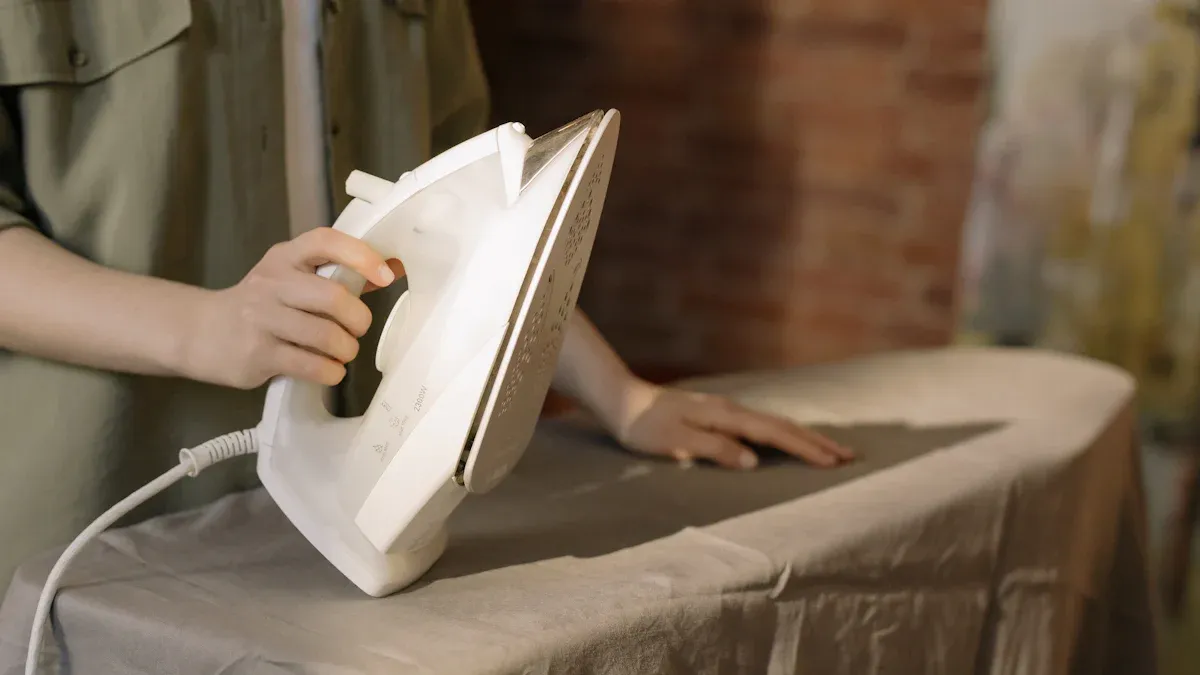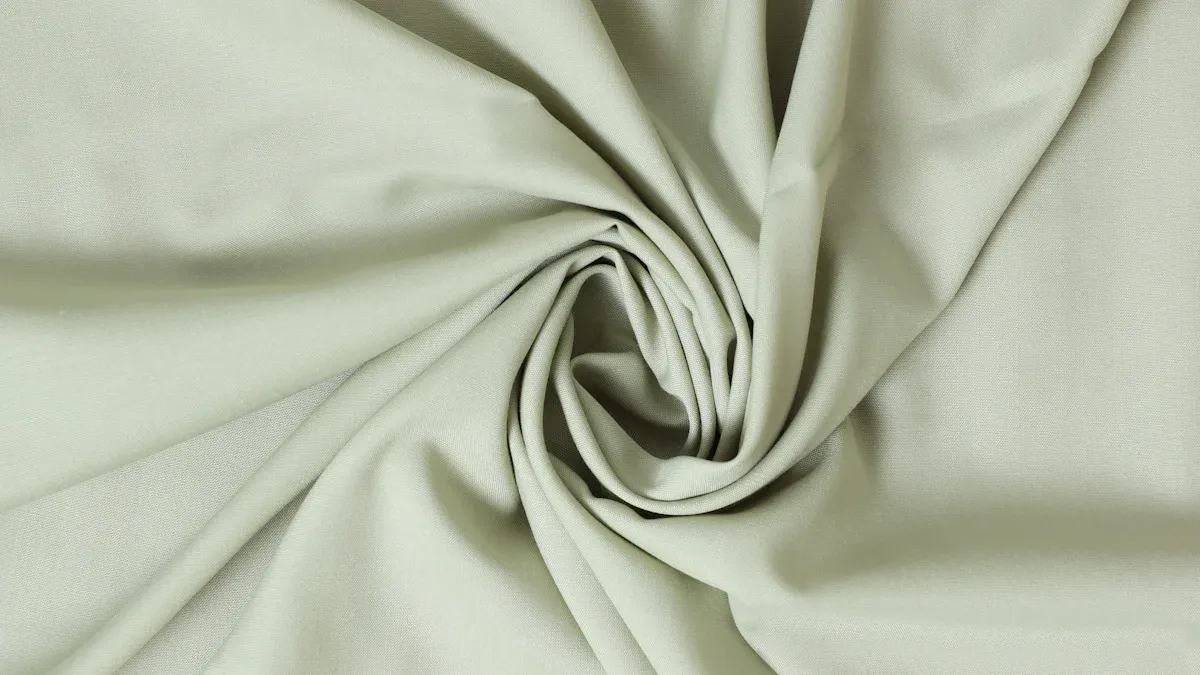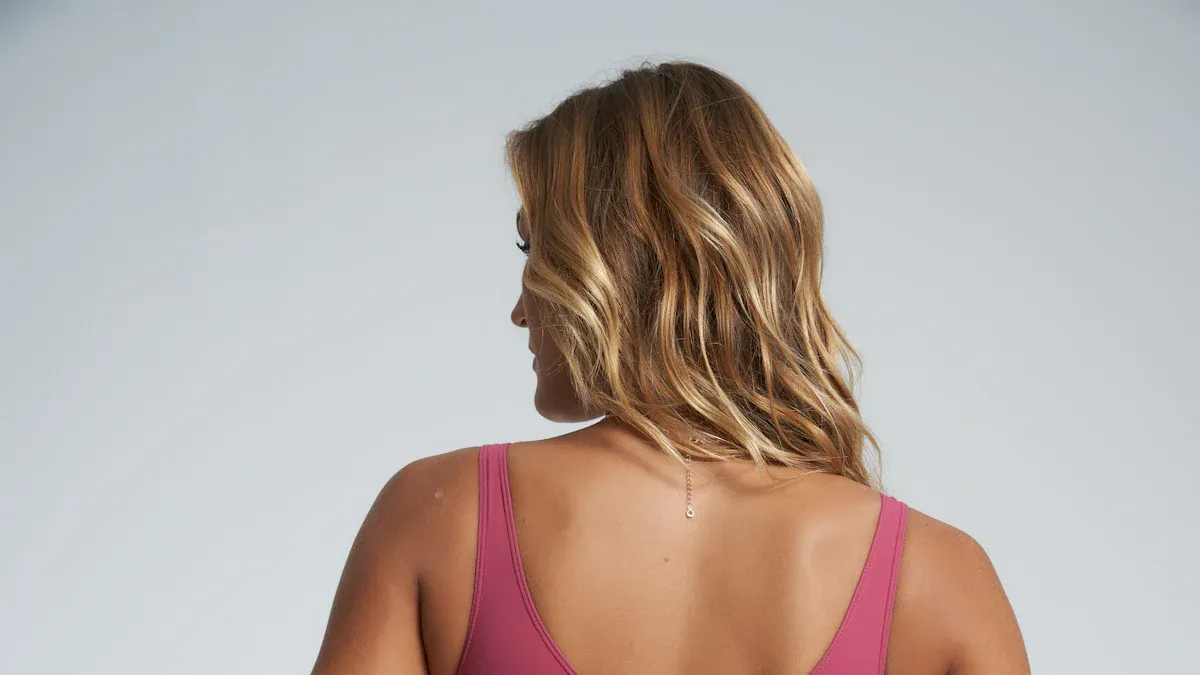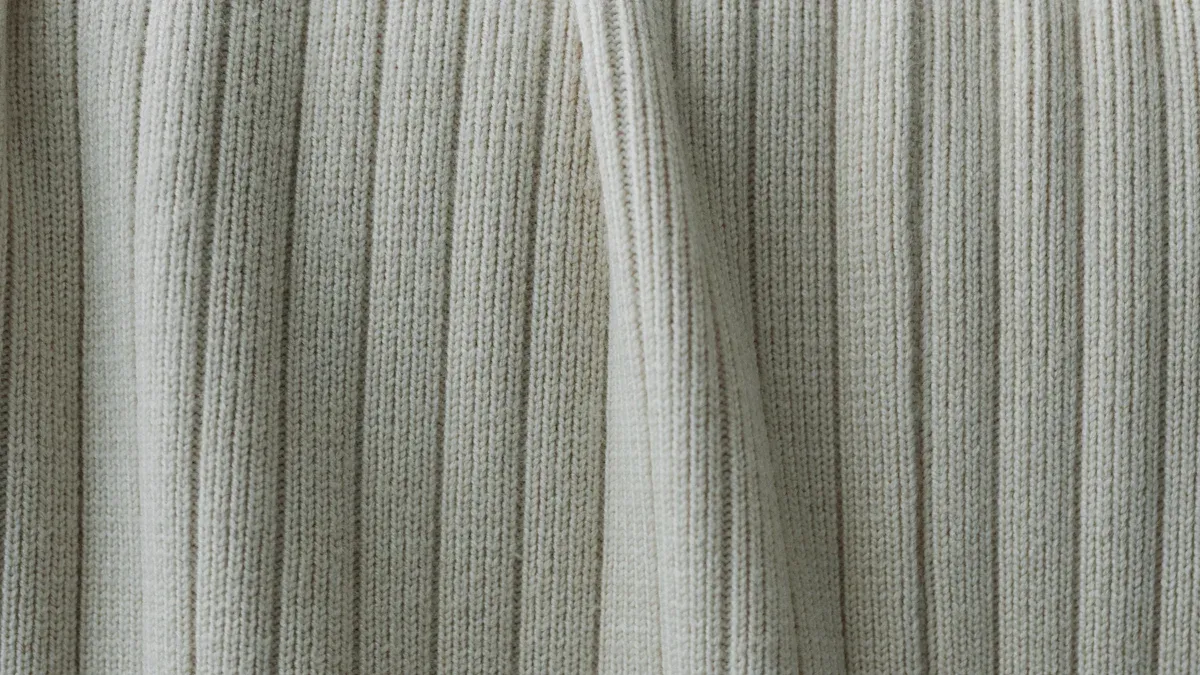
No, you should not iron scuba fabric. This material reacts poorly to high heat, which can cause permanent damage. Suerte’s Scuba Fabric is made to resist wrinkles, so you usually do not need to worry about creases. If you want to keep your clothes looking great, you have safer options than using an iron. With the right care, your favorite pieces will stay smooth and stylish.
Key Takeaways
- Do not iron scuba fabric. High heat can melt the fibers and ruin the texture.
- Scuba fabric is wrinkle-resistant. You can keep it looking great without ironing.
- Use steaming or gentle smoothing by hand to remove wrinkles safely.
- Wash scuba fabric in cold water with mild detergent to maintain its quality.
- Air dry your scuba garments to help them last longer and keep their shape.
Why Avoid Ironing Scuba Fabric
Scuba Fabric Properties
When you pick up scuba fabric, you notice how smooth and thick it feels. This material stands out because of its double-knit construction. That means two layers of fabric get knitted together, making it strong and giving it a bit of stretch. You can bend, twist, or pull it, and it bounces right back into shape. That’s why so many designers love using scuba fabric for fitted dresses, jackets, and even activewear.
The secret behind its wrinkle resistance comes from the fibers inside. Most scuba fabric uses synthetic fibers like polyester and spandex. These fibers go through special chemical processes that make them tough and smooth. Because of this, your clothes made from scuba fabric rarely show creases or wrinkles, even after a long day. You can pack a scuba dress in your suitcase, pull it out, and it still looks fresh. This makes scuba fabric a favorite for travel and busy days when you want to look polished with little effort.
Tip: Suerte’s premium scuba fabric takes wrinkle resistance to the next level. You get a fabric that keeps its shape and stays smooth, so you spend less time worrying about ironing or steaming.
Heat Sensitivity Risks
You might wonder why you can’t just iron out a stubborn fold if you ever see one. The answer comes down to how scuba fabric reacts to heat. The double-knit layers make the fabric warm and comfortable, but they also make it sensitive to high temperatures. When you use an iron, even on a low setting, you risk damaging the fabric.
Here’s what happens when scuba fabric meets too much heat:
- The fibers can start to melt at around 240 degrees Celsius.
- Even temperatures between 200 and 215 degrees Celsius can cause harm.
- The fabric may lose its smooth surface or even stick to the iron.
Scuba fabric doesn’t hold a crease well, so ironing doesn’t really help. Instead, you might end up with shiny spots or a warped texture. That’s why it’s safer to skip the iron altogether.
Let’s look at what some studies say about heat and scuba fabric:
| Study | Focus | Findings |
|---|---|---|
| Lafère et al. (2021) | Insulation provided by dry or wetsuits | Looked at how well the fabric protects against cold water immersion. |
| Lundell et al. (2019) | Thermal insulating gases in drysuit dives | Compared different gases for insulation during Arctic diving. |
These studies show that scuba fabric works well for insulation, but they also highlight how heat can change its properties. You want to keep your scuba fabric looking and feeling its best, so avoiding high heat is key.
Note: Always test a small, hidden area if you ever feel tempted to use heat. But with Suerte’s wrinkle-resistant scuba fabric, you probably won’t need to!
If you want a fabric that stays smooth, keeps its shape, and doesn’t need much fuss, scuba fabric is a smart choice. Just remember, ironing is not your friend here. There are better ways to care for your favorite pieces, and you’ll learn about those in the next sections.
What If You Iron Scuba Fabric?
Visible Signs of Damage When Scuba Fabric Is Ironed
If you ever try to iron scuba fabric, you might notice problems right away. The first thing you could see is a change in color. High heat can make the dye in scuba fabric fade or even disappear. This discoloration often shows up as shiny or dull patches that stand out from the rest of your garment. Sometimes, the fabric may even stick to the iron, leaving behind a rough or warped spot.
You might also spot small burns or charring, especially if you leave the iron in one place for too long. These marks not only look bad but also weaken the fabric. When the fibers get too hot, they can lose their smooth surface and start to break down. That means your scuba fabric might tear more easily or lose its shape.
Tip: If you see any of these signs, stop ironing right away. Let the fabric cool and check for further damage before wearing or washing it.
Long-Term Damage from Ironing
Ironing scuba fabric once can cause visible damage, but repeated ironing leads to bigger problems. Over time, the heat breaks down the fibers inside the fabric. This makes the material weaker and less stretchy. You might notice that your favorite dress or hoodie does not bounce back like it used to.
Here are some long-term effects of ironing scuba fabric:
- The fabric loses its wrinkle-resistant quality.
- The surface becomes rough or shiny in spots.
- The material may start to tear or develop holes.
- The moisture-wicking barrier can break down, making the fabric less comfortable.
Scuba fabric is designed to stay smooth without ironing. If you keep using heat, you risk ruining the structure and look of your clothes. Gentle handling is always best. You do not need to iron scuba fabric to keep it looking great.
Remember, with scuba fabric, less is more. Skip the iron and enjoy how easy it is to care for your favorite pieces!
Safe Alternatives for Scuba Fabric
Steaming Scuba Fabric
You want your scuba fabric to look smooth and fresh, but you know ironing is not safe. Steaming gives you a gentle way to remove wrinkles without risking damage. A handheld steamer works well for this job. Hold the steamer a few inches away from the fabric and move it slowly over the area with wrinkles. The steam relaxes the fibers, so the fabric smooths out on its own.
If you do not have a steamer, you can hang your scuba fabric in the bathroom while you take a hot shower. The steam from the shower helps loosen any creases. Just make sure the fabric does not get wet. Always let your scuba fabric air dry after steaming. This keeps it looking new and helps it last longer.
Many people use steamers on marine vinyl, which is similar to scuba fabric. Steaming works well, but you must be careful not to hold the steamer too close or in one spot for too long. Too much heat can still harm the fabric. Always keep the steamer moving and check the fabric as you go.
Tip: Test a small, hidden spot first if you are unsure how your scuba fabric will react to steam.
Hanging and Smoothing Scuba Fabric
You might think hanging your scuba fabric is the best way to keep it wrinkle-free. However, experts suggest other methods work better. Take a look at the table below for the best ways to care for your scuba fabric:
| Care Instruction | Recommendation |
|---|---|
| Hanging the garment | Not recommended |
| Laying the cloth on a towel | Preferred method |
| Storing the scuba garment folded | Recommended |
Lay your scuba fabric flat on a clean towel to help it keep its shape. Gently smooth out any wrinkles with your hands. Folding the fabric and storing it in a drawer also works well. These methods protect the structure and appearance of your scuba fabric, so it stays looking great for a long time.
Remember, gentle care keeps your scuba fabric looking its best. Skip the iron and try these easy alternatives!
Scuba Fabric Care and Maintenance

Washing Tips for Scuba Fabric
Taking care of your scuba fabric starts with the right washing routine. Suerte recommends you wash by hand in cold water using a mild detergent. If you prefer a machine, turn your garment inside out and place it in a mesh bag. Always choose the delicate cycle and use cold or lukewarm water, around 30 to 40ºC. This protects the spandex and lycra fibers inside. Never use bleach, as it can harm the fabric. When you finish washing, gently squeeze out the water. Do not twist or wring your scuba crepe material. This keeps the shape and texture just right.
Drying and Storage
After washing, you want to keep your scuba fabric looking its best. Lay your garment flat or hang it to air dry, but avoid direct sunlight. High heat from a dryer can ruin the stretch and feel of your scuba crepe material. Here’s a quick table to help you remember the best drying tips:
| Recommendation | Details |
|---|---|
| Wash Temperature | 30 degrees on low heat |
| Bleach Usage | Should not be used |
| Dryer Usage | Should not be preferred |
| Ironing Instructions | Iron backwards on low steam |
When storing, keep your scuba crepe fabric in a clean, dry space. Fold items carefully and avoid rough surfaces or sharp objects. Store them away from sunlight and high temperatures. This helps your scuba crepe material last longer and look great every time you wear it.
Stain Removal Tips for Scuba Fabric
If you spill something on your scuba crepe fabric, act fast. Blot the stain gently with a clean cloth. Use cold water and a mild detergent to spot clean. Avoid rubbing, as this can push the stain deeper. For tough stains, soak the area in cold water before washing. Never use harsh chemicals or bleach on your scuba crepe material. These steps help you keep your scuba fabric fresh and bright.
Scuba Crepe Material Care
Scuba crepe material stands out for its shape retention, stretch, and color. You can wash scuba crepe fabric at 86°F or use cold water on a gentle cycle. For drying, hang to dry or use low tumble dry heat. Always iron on low heat, and place a cloth between the iron and your scuba crepe fabric. Never wring the fabric. This keeps the texture smooth and the color bold. Scuba crepe material works well for both casual and formal wear. It holds its shape, resists pilling, and stays comfortable all day. With proper care and maintenance, your scuba crepe material will look new after many washes. Washing scuba crepe fabric the right way means you get the most out of every piece. You can trust Suerte’s scuba fabric and scuba crepe material for fashion and activewear that lasts.
You don’t need to iron scuba fabric to keep it looking sharp. Simple care steps make a big difference.
- Wash regularly with mild detergent to protect stretch and comfort.
- Air dry your garments to help them last longer.
- Suerte’s scuba fabric stands out for its moisture management, breathability, and durability.
You can trust these pieces for fashion and activewear. Try Suerte’s products and see how easy it is to look great every day.
FAQ
Can I use a regular iron on scuba fabric?
No, you should not use a regular iron on scuba fabric. High heat can melt or damage the fibers. You risk ruining the smooth texture. Stick with steaming or gentle smoothing by hand.
What is the best way to remove wrinkles from scuba fabric?
Hang your garment in the bathroom while you shower. The steam helps relax wrinkles. You can also use a handheld steamer. Always keep the steamer moving and hold it a few inches away from the fabric.
How do I store scuba fabric clothes?
Fold your scuba fabric clothes and place them in a drawer or on a shelf. Avoid hanging them for long periods. This helps keep their shape and prevents stretching.
Can I machine wash scuba fabric?
Yes, you can machine wash scuba fabric. Turn the garment inside out and use a mesh bag. Choose a gentle cycle with cold water. Use mild detergent for best results.
Does scuba fabric shrink after washing?
Scuba fabric usually does not shrink if you wash it in cold water and air dry it. Avoid hot water and high heat from dryers. This keeps your clothes looking new.



